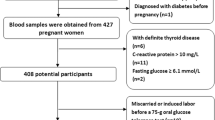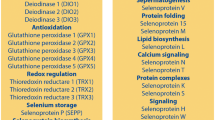Abstract
In consideration of the potential roles of selenoproteins in thyroid function, we aimed to evaluate the association of low selenium status with hypothyroidism during pregnancy and the association of maternal low thyroid function with infant birth size. We conducted a prospective birth cohort study in Shanghai in 2010 and investigated 1931 pregnant mothers of gestational weeks 28–36. Maternal serum selenium and thyrotropin (TSH) levels were determined and birth weights and lengths of newborns were measured. Other covariates were obtained through maternal interviews and medical records. A non-linear association was observed between maternal selenium and TSH levels. Two-piecewise multivariable linear regression models were therefore applied to assess the association of serum selenium with TSH levels, and multivariable linear regression models were applied to assess the association of TSH levels with birth weight/length. Adjusting for potential confounders, when maternal serum selenium levels < 103.7 μg/L (P25th), each unit increase in selenium levels (μg/L) was significantly associated with a decrease of 0.014 μIU/mL in TSH levels (β = − 0.014, 95%CI − 0.025, − 0.002, P = 0.023). However, when selenium levels ≥ 103.7 μg/L, there were no significant relationships between selenium and TSH (β = 0.000, 95%CI − 0.001, 0.002, P = 0.859). Maternal TSH levels were significantly inversely associated with infant birth weight (β = − 0.060, 95%CI − 0.100, − 0.010, P = 0.010). We observed a non-linear association between maternal selenium status and TSH levels. Low selenium status during pregnancy may associate with low thyroid function that was related with low birth weights.

.


Similar content being viewed by others
Data Availability
Restrictions apply to the availability of data generated or analyzed during this study to preserve patient confidentiality or because they were used under license. The corresponding author will on request detail the restrictions and any conditions under which access to some data may be provided.
References
Bobak M (2000) Outdoor air pollution, low birth weight, and prematurity. Environ Health Perspect 108(2):173–176
Fanaroff AA, Stoll BJ, Wright LL, Carlo WA, Ehrenkranz RA, Stark AR, Bauer CR, Donovan EF, Korones SB, Laptook AR, Lemons JA, Oh W, Papile LA, Shankaran S, Stevenson DK, Tyson JE, Poole WK (2007) Trends in neonatal morbidity and mortality for very low birthweight infants. Am J Obstet Gynecol 196(2):147.e1–147.e8
Bezerra RM, Castro V, Sales T, Jr Passini R, Marba ST, Saad ST, Saad MJ (2002) The Gly972Arg polymorphism in insulin receptor substrate-1 is associated with decreased birth weight in a population-based sample of Brazilian newborns. Diabetes Care 25(3):550–553
Hovi P, Vohr B, Ment LR, Doyle LW, McGarvey L, Morrison KM, Evensen KA, van der Pal S, Grunau RE, Brubakk AM, Andersson S, Saigal S, Kajantie E (2016) Blood pressure in young adults born at very low birth weight: adults born preterm international collaboration. Hypertension (Dallas, Tex: 1979) 68(4):880–887
Johansson S, Iliadou A, Bergvall N, Faire U, Kramer MS, Pawitan Y, Pedersen NL, Norman M, Lichtenstein P, Cnattingius S (2008) The association between low birth weight and type 2 diabetes: contribution of genetic factors. Epidemiology 19(5):659–665
Jornayvaz FR, Vollenweider P, Bochud M, Mooser V, Waeber G, Marques-Vidal P (2016) Low birth weight leads to obesity, diabetes and increased leptin levels in adults: the CoLaus study. Cardiovasc Diabetol 15:73
Hać E, Krechniak J, Szyszko M (2002) Selenium levels in human plasma and hair in northern Poland. Biol Trace Elem Res 85(3):277–285
Drutel A, Archambeaud F, Caron P (2013) Selenium and the thyroid gland: more good news for clinicians. Clin Endocrinol 78(2):155–164
Polanska K, Hanke W, Krol A, Gromadzinska J, Kuras R, Janasik B, Wasowicz W, Mirabella F, Chiarotti F, Calamandrei G (2017) Micronutrients during pregnancy and child psychomotor development: opposite effects of zinc and selenium. Environ Res 158:583–589
Kohrle J, Jakob F, Contempre B, Dumont JE (2005) Selenium, the thyroid, and the endocrine system. Endocr Rev 26(7):944–984
Rayman MP (2012) Selenium and human health. Lancet 379(9822):1256–1268
Roman M, Jitaru P, Barbante C (2014) Selenium biochemistry and its role for human health. Metallomics 6(1):25–54
Wu Q, Rayman MP, Lv H, Schomburg L, Cui B, Gao C, Chen P, Zhuang G, Zhang Z, Peng X, Li H, Zhao Y, He X, Zeng G, Qin F, Hou P, Shi B (2015) Low population selenium status is associated with increased prevalence of thyroid disease. J Clin Endocrinol Metab 100(11):4037–4047
Andrade GRG, Gorgulho B, Lotufo PA, Bensenor IM, Marchioni DM (2018) Dietary selenium intake and subclinical hypothyroidism: a cross-sectional analysis of the ELSA-Brasil study. Nutrients 10(6):E693
Winther KH, Bonnema SJ, Cold F, Debrabant B, Nybo M, Cold S, Hegedüs L (2015) Does selenium supplementation affect thyroid function? Results from a randomized, controlled, double-blinded trial in a Danish population. Eur J Nutr 172(6):657–667
Mao J, Pop VJ, Bath SC, Vader HL, Redman CW, Rayman MP (2016) Effect of low-dose selenium on thyroid autoimmunity and thyroid function in UK pregnant women with mild-to-moderate iodine deficiency. Eur J Nutr 55(1):55–61
Klapec T, Cavar S, Kasac Z, Rucevic S, Popinjac A (2008) Selenium in placenta predicts birth weight in normal but not intrauterine growth restriction pregnancy. J Trace Elem Med Biol 22(1):54–58
Sun H, Chen W, Wang D, Jin Y, Chen X, Xu Y (2014) The effects of prenatal exposure to low-level cadmium, lead and selenium on birth outcomes. Chemosphere 108:33–39
Tsuzuki S, Morimoto N, Hosokawa S, Matsushita T (2013) Associations of maternal and neonatal serum trace element concentrations with neonatal birth weight. PLoS One 8(9):e75627
Rashid M, Rashid MH (2007) Obstetric management of thyroid disease. Obstet Gynecol Surv 62(10):680–688 quiz 691
Liu H, Shan Z, Li C, Mao J, Xie X, Wang W, Fan C, Wang H, Zhang H, Han C, Wang X, Liu X, Fan Y, Bao S, Teng W (2014) Maternal subclinical hypothyroidism, thyroid autoimmunity, and the risk of miscarriage: a prospective cohort study. Thyroid 24(11):1642–1649
Allan WC, Haddow JE, Palomaki GE, Williams JR, Mitchell ML, Hermos RJ, Faix JD, Klein RZ (2000) Maternal thyroid deficiency and pregnancy complications: implications for population screening. J Med Screen 7(3):127–130
Ashoor G, Maiz N, Rotas M, Jawdat F, Nicolaides KH (2010) Maternal thyroid function at 11 to 13 weeks of gestation and subsequent fetal death. Thyroid 20(9):989–993
Casey BM, Dashe JS, Wells CE, McIntire DD, Byrd W, Leveno KJ, Cunningham FG (2005) Subclinical hypothyroidism and pregnancy outcomes. Obstet Gynecol 105(2):239–245
Blazer S, Moreh-Waterman Y, Miller-Lotan R, Tamir A, Hochberg Z (2003) Maternal hypothyroidism may affect fetal growth and neonatal thyroid function. Obstet Gynecol 102(2):232–241
Vrijkotte TG, Hrudey EJ, Twickler MB (2017) Early maternal thyroid function during gestation is associated with fetal growth, particularly in male newborns. J Clin Endocrinol Metab 102(3):1059–1066
Zhang Y, Fan Y, Yu X, Wang X, Bao S, Li J, Fan C, Shan Z, Teng W (2015) Maternal subclinical hypothyroidism impairs neurodevelopment in rat offspring by inhibiting the CREB signaling pathway. Mol Neurobiol 52(1):432–441
Chen LM, Du WJ, Dai J, Zhang Q, Si GX, Yang H, Ye EL, Chen QS, Yu LC, Zhang C, Lu XM (2014) Effects of subclinical hypothyroidism on maternal and perinatal outcomes during pregnancy: a single-center cohort study of a Chinese population. PLoS One 9(10):e109364
Leung AS, Millar LK, Koonings PP, Montoro M, Mestman JH (1993) Perinatal outcome in hypothyroid pregnancies. Obstet Gynecol 81(3):349–353
Schneuer FJ, Nassar N, Tasevski V, Morris JM, Roberts CL (2012) Association and predictive accuracy of high TSH serum levels in first trimester and adverse pregnancy outcomes. J Clin Endocrinol Metab 97(9):3115–3122
Su PY, Huang K, Hao JH, Xu YQ, Yan SQ, Li T, Xu YH, Tao FB (2011) Maternal thyroid function in the first twenty weeks of pregnancy and subsequent fetal and infant development: a prospective population-based cohort study in China. J Clin Endocrinol Metab 96(10):3234–3241
Lin Y, Hu W, Xu J, Luo Z, Ye X, Yan C, Liu Z, Tong S (2017) Association between temperature and maternal stress during pregnancy. Environ Res 158:421–430
Jiang SW, Yang B, Xu J, Liu ZW, Yan CH, Zhang JS, Li SF, Shen XM (2018) Associations of internal-migration status with maternal exposure to stress, lead, and selenium deficiency among pregnant women in Shanghai, China. Biol Trace Elem Res 190(2):309–317
Li S, Xu J, Liu Z, Yan CH (2017) The non-linear association between low-level lead exposure and maternal stress among pregnant women. Neurotoxicology 59:191–196
Wang J, Yang LS, Li HR, Li YH, Wei BG (2018) Dietary selenium intake based on the Chinese food pagoda: the influence of dietary patterns on selenium intake. Nutr J 17:50
Derumeaux H, Valeix P, Castetbon K, Bensimon M, Boutron-Ruault MC, Arnaud J, Hercberg S (2003) Association of selenium with thyroid volume and echostructure in 35- to 60-year-old French adults. Eur J Endocrinol 148(3):309–315
Nader R (2017) Tietz textbook of clinical chemistry and molecular diagnostics 6th. WB Saunders, Philadelphia, pp710
Arthur JR, Nicol F, Beckett GJ (1993) Selenium deficiency, thyroid hormone metabolism, and thyroid hormone deiodinases. Am J Clin Nutr 57(2 Suppl):236S–239S
Karakosta P, Alegakis D, Georgiou V, Roumeliotaki T, Fthenou E, Vassilaki M, Boumpas D, Castanas E, Kogevinas M, Chatzi L (2012) Thyroid dysfunction and autoantibodies in early pregnancy are associated with increased risk of gestational diabetes and adverse birth outcomes. J Clin Endocrinol Metab 97(12):4464–4472
Chen Z, Xi Y, Yong Z, Fei G, Shuai Y, Robin PP, Tim IMK, Jianxia F, Hefeng H (2019) Association between maternal thyroid hormones and birth weight at early and late pregnancy. J Clin Endocrinol Metab 104(12):5853–5863
Iranpour R, Zandian A, Mohammadizadeh M, Mohammadzadeh A, Balali-Mood M, Hajiheydari M (2009) Comparison of maternal and umbilical cord blood selenium levels in term and preterm infants. Zhongguo dang dai er ke za zhi 11(7):513–516
Rayman MP (2000) The importance of selenium to human health. Lancet 356(9225):233–241
Bogden JD, Kemp FW, Chen X, Stagnaro-Green A, Stein TP, Scholl TO (2006) Low-normal serum selenium early in human pregnancy predicts lower birth weight. Nutr Res 26(10):497–502
Mistry HD, Kurlak LO, Young SD, Briley AL, Pipkin FB, Baker PN, Poston L (2014) Maternal selenium, copper and zinc concentrations in pregnancy associated with small-for-gestational-age infants. Matern Child Nutr 10(3):327–334
Negro R, Schwartz A, Gismondi R, Tinelli A, Mangieri T, Stagnaro-Green A (2011) Thyroid antibody positivity in the first trimester of pregnancy is associated with negative pregnancy outcomes. J Clin Endocrinol Metab 96(6):E920–E924
Hybsier S, Schulz T, Wu Z, Demuth I, Minich WB, Renko K, Rijntjes E, Köhrle J, Strasburger CJ, Steinhagen-Thiessen E, Schomburg L (2017) Sex-specific and inter-individual differences in biomarkers of selenium status identified by a calibrated ELISA for selenoprotein P. Redox Biol 11:403–414
Funding
This study was supported by the National Natural Science Foundation of China (NCFS, 81974486, 81673189, 30906295), Shanghai Jiao Tong University School of Medicine Gaofeng Clinical Medicine Grant Support (20172016), Shanghai Health and Family Planning Commission (201640363), National Key Research and Development Program of China (2016YFC1000203).
Author information
Authors and Affiliations
Corresponding author
Ethics declarations
Conflict of Interest
The authors declare that they have no conflicts of interest.
Additional information
Publisher’s Note
Springer Nature remains neutral with regard to jurisdictional claims in published maps and institutional affiliations.
Rights and permissions
About this article
Cite this article
Guo, X., Zhou, L., Xu, J. et al. Prenatal Maternal Low Selenium, High Thyrotropin, and Low Birth Weights. Biol Trace Elem Res 199, 18–25 (2021). https://doi.org/10.1007/s12011-020-02124-9
Received:
Accepted:
Published:
Issue Date:
DOI: https://doi.org/10.1007/s12011-020-02124-9




